Veterinary software is evolving rapidly thanks to advancements in AI. How is the veterinary management software market changing? What features veterinary management software developers add to their products? What do customers of software for veterinarians like, and what don't they? This overview is helpful not only for those looking to buy ready-made veterinary computer software, but also for veterinary software startups founders planning to create innovative veterinary management solutions. To succeed, they need to understand current market trends and future expectations.
Veterinary Management Software Market
The amount spent on pets is constantly increasing, driving growth in the relevant market. The U.S. has the highest number of veterinary clinics and veterinarians, which explains why the top animal healthtech companies are based there.
Some researchers estimated that the global veterinary software market would reach nearly USD 1.5 billion in 2024 and predict an annual growth rate of over 10%, making this market promising for innovative startups.
Modern veterinary Practice Management Software is cloud-based and must address the following:
- Administrative tasks: billing and invoicing, resource management, inventory control.
- Clinical tasks: treatment procedure management, tracking health conditions.
- Communication tasks: online appointment booking, email or SMS reminders, and patient portals.
It should also integrate with various external databases and third-party platforms (imaging, telehealth, finance & analytics, insurance, medical records, client communication tools, payment, controlled drugs management, diagnostics, online pharmacy, patient care, reference labs, etc.) and have built-in data analysis capabilities for insights into patient demographics, treatment outcomes, or clinic performance.
Recently, veterinary software has gained a new wave of development due to advancements in AI. New projects in this field focus on implementing:
- Predictive analytics to identify at-risk patients and prevent diseases.
- Machine learning (ML) for early and timely diagnosis using medical images (MRI and X-rays).
- AI-powered chatbots to improve client communication, provide veterinary assistance, and deliver personalized treatment plans.
Regarding the target buyers of such software, there are two key categories:
- Veterinary hospitals and clinics that handle a high patient volume and increased patient load. Their software must support operations in surgery, imaging, emergency care, and specialized treatments.
- Smaller practices or individual veterinarians treating small animals (dogs and cats, as well as small mammals, reptiles, birds, aquatics, and exotic pets). Ownership of exotic pets is a growing trend, further increasing demand in this segment.
Covetrus Pulse Veterinary Management Software
Covetrus is probably the most well-known among brands of veterinary management software in the market. It has raised a total of $292 million over seven funding rounds. Let’s take a look at their product. We’ll focus on the design and description of the interfaces for its most basic features.
Patient's Dashboard
The patient's dashboard highlights a pet’s status (hospitalized, ready for checkout, etc.), weight trend, core vaccines with expiration dates, reminders for procedures or vaccinations, as well as a visits log. It also integrates with the prescription management module to create and synchronize prescriptions.
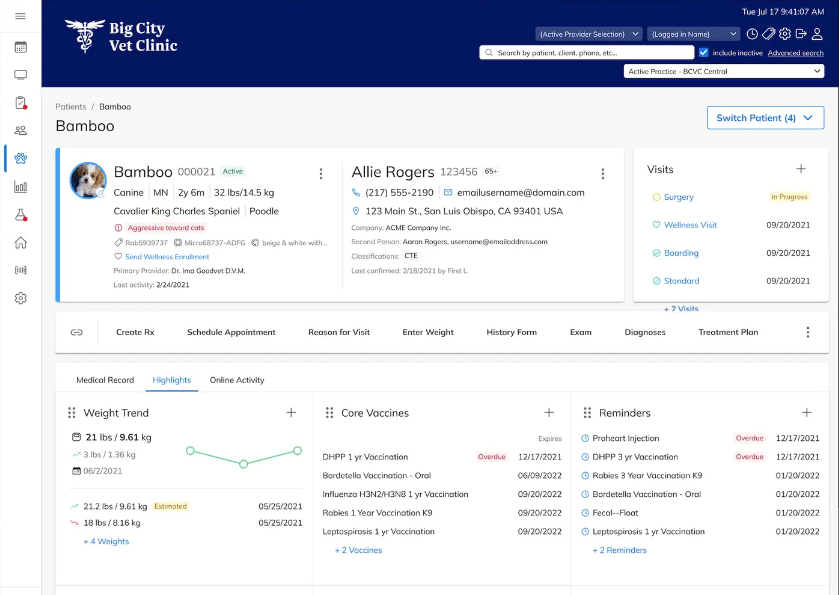
Patients' Dashboard
The whiteboard dashboard contains all the important details for each patient—name, species, breed, weight, and gender—along with their appointment type, current status, assigned veterinarian, and location within the clinic. It also includes a filter to prioritize patients. Users can view and update treatments or tasks for each patient by clicking the "+" button. The comments section provides additional information on the patient's condition.
Communication Dashboard
The SMS client dashboard allows staff to send text messages directly to clients through the veterinary practice management software. They can select which phone number to use if multiple numbers are listed. A pre-filled text box is available for composing or editing the message before sending. This communication is linked to the patient's record on the whiteboard.
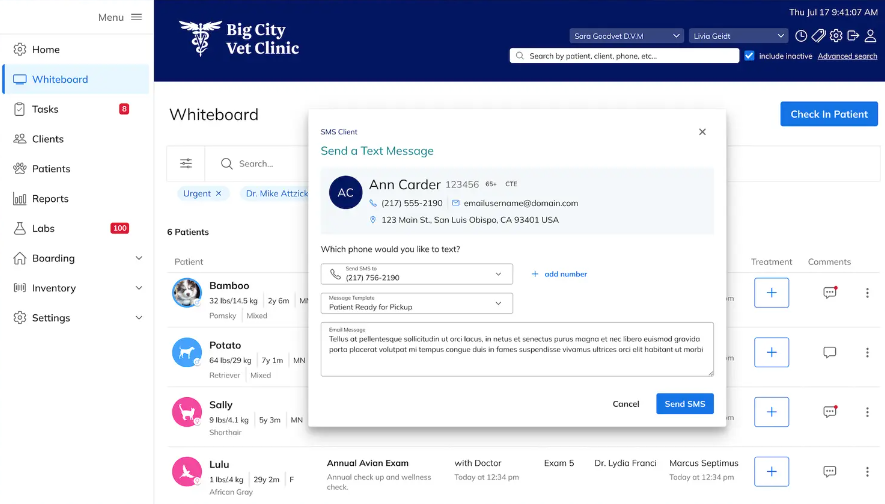
Prescription Dashboard
The prescription dashboard allows veterinarians to easily create prescription requests for a patient. The interface displays patient details (weight, breed, and medical status) and connects the patient to their owner. They can adjust details (dosage or refills) before finalizing the prescription. Once approved, the prescription can be sent directly to the Online Pharmacy module, enabling clients to place an order for the medication.
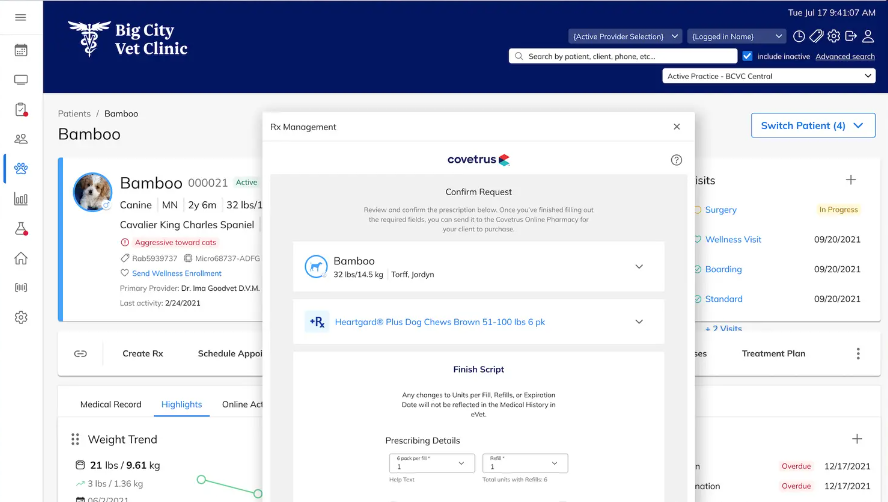
Digitail Veterinary Management Software
Digitail is another example of a SaaS vet practice management platform that automates admin for veterinarians and provides a pet parent app for pet owners. It has raised $13.8M.
AI-powered veterinary assistant
This veterinary practice information management system has an AI Dictation feature that allows notes to be completed before the end of the day, even if a veterinarian has a full appointment schedule, because recording a SOAP note with AI is several times faster than typing it out.
Scheduling
Doctors can configure their calendar by setting up availability, services, and durations. They can accept, reschedule, or cancel bookings on the go. Reminders for upcoming appointments and recommended visits will be sent automatically via email, text, and push notifications to clients.
Patient Check-in & Intake
Administrators can manage visits on a single screen, for example, prioritize them with appointment statuses and see real-time waiting times. Clients can schedule appointments themselves, approve consent and sign estimates digitally.
Medical Exam
Billing & Checkout
Follow ups
Easyvet Veterinary Management Software
Easyvet veterinary practice management software is one example of this fragmented market. It’s worth mentioning that it has raised $15.2 million from different investors. The tech support is in Germany, and for clinics in Canada and the USA, it's not easy to connect with them. Let's take a look at their design and featured functions.
Scheduling
The appointment dashboard for vets and vet techs shows a snapshot of their day.
Teams can manage appointments in a unified dashboard, access associated records, fill slots via online and phone bookings, block out availability in the calendar, track diagnostic requests, monitor upcoming medication refills, and track patient appointment statuses and progress from initial booking to discharge.
The customer portal lets clients check their profiles, track invoices, and view upcoming visits and prescriptions.
Communication
The system can send appointment reminders, updates, and product promotions automatically. These messages may be timed to reach clients when they are most impactful.
This feature uses SMS (with a 90% open rate) to send reminders and receive confirmations directly from clients. When a client responds, the platform automatically updates appointment statuses in the clinic's calendar.
Clients can sign consent forms and documents electronically via a customer portal, so there is no need for in-person visits or printed paperwork.
Invoicing
The platform generates secure online payment links sent directly to clients via SMS or email. Payments processed through these links are automatically allocated to the correct account in ezyVet.
Integrated pet insurance processing and electronic claim submission are activated with a one-touch button.
The financial documents section contains customizable templates for statements, invoices, receipts, and estimates. These templates automatically personalize using client data and practice branding.
Automatic invoice creation prevents repetitive data entry and maintains consistency in client interactions and clinical reporting.
Revenue capture automation works through preconfigured appointment invoicing templates, automated discount application rules, and real-time treatment-to-billing synchronization. The system flags unbilled services and automatically generates invoices when clinical notes are completed.
Reporting
ezyVet offers features designed to enhance veterinary practice management through detailed analytics.
It allows the evaluation of finances, clinical history, appointments, stock, and customer data by analyzing average invoice amounts, active clients, revenue by vet, product groups, appointment types, and year-over-year comparisons to identify high- and low-performing areas.
Report delivery can be automated by configuring filters to select what to include, scheduling frequencies (weekly, monthly, or yearly), and having the results emailed directly to stakeholders.
Veterinary Management Software Reviews
What paying customers disliked about veterinary management software? This is a potential area for improvement by the current vendor or ideas for implementation by new startups. Below is the information from verified user comments posted on SoftwareAdvice.
Performance
Customers don't like when veterinary software is time-consuming (too many button clicks, dozens steps for every one thing you need to do), glitchy, freezing too often, extremely slow, and when it includes many clunky, difficult processes that require tech support.
Veterinary clinic staff hate when veterinary software crashes while generating and sending medical records, and when it takes a very long time to complete the process, so they have to send records several times by segments.
Search
They complain about the poor search functionality. When trying to find clients, patients, or codes, the veterinary software may populate everything containing those letters. It’s difficult for them to search a patient’s medical history since there may be no search bar to look up specific words like “exam” without scrolling through the entire history.
Invoicing
The invoicing functionality may be so rigid in veterinary software that there’s no simple way to add or remove items from an invoice, return items, issue refunds, or void payments. Customers can’t perform basic actions like attaching a PDF to invoice items to comply with Lizzie’s Law. The process of adding or removing services after they’ve been added to an invoice is too time-consuming. Clients can’t change the billing doctor during checkout with one click—they must manually update every single item in the invoice individually.
Scheduling
The veterinary software may lack a reschedule button. Because of this, clients have to cancel the appointment and return to the medical record to create a new one.
Integrations
Clients are dissatisfied with how veterinary software sets up integrations with third-party tools. In their opinion, many integrations do not work correctly or reliably. Additionally, clients often use software that isn’t included in the official list of integrations.
Customer Service
Customer service operates may operate formally, make promises for improvements, but months pass, and nothing changes. That’s the best-case scenario—often, they simply say the requested functionality isn’t supported and tell users to figure it out themselves. Moreover, when updates do happen, users feel that they’ve made the situation worse rather than better.
Migrations
The transition from other vendors isn’t smooth. Many data pieces often don’t migrate at all and need to be entered manually.
Other frustrating issues
- Deceased pets cannot be hidden from the client’s active account.
- Not all dog breeds are listed for selection when creating a profile.
- Mass updating of inventory, labs, or services is unavailable. Users have to click "edit" for each item, make the changes, then save and close before moving on to the next.
How Belitsoft Can Help with Veterinary Management Software Development
Belitsoft develops custom cloud-based veterinary software on demand. For veterinary software development we provide developers, designers, and project managers. We improve existing software, modernize it, or create it entirely from scratch.
We help develop custom veterinary management software with features like appointment scheduling, medical records management, reporting and analytics, compliance and documentation, workflow automation, staff management, lab integration, and insurance processing. We can also implement advanced features such as telemedicine services (video and chat consultations, automated email invites, two-way texting, and video launch from calendars), pet portals (tracking pet health records, nutrition, and treatment plans), prescription management (automated e-prescribing, and automated re-ordering), accounting and billing modules (automating payment processing, invoice generation, and expense tracking), inventory management systems, pet GPS tracking.
Rate this article
Recommended posts
Portfolio
Our Clients' Feedback

















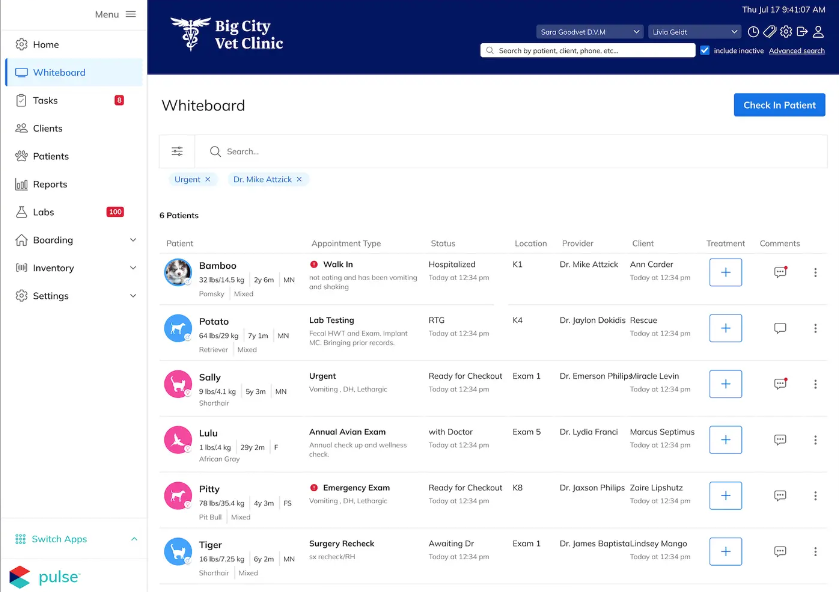
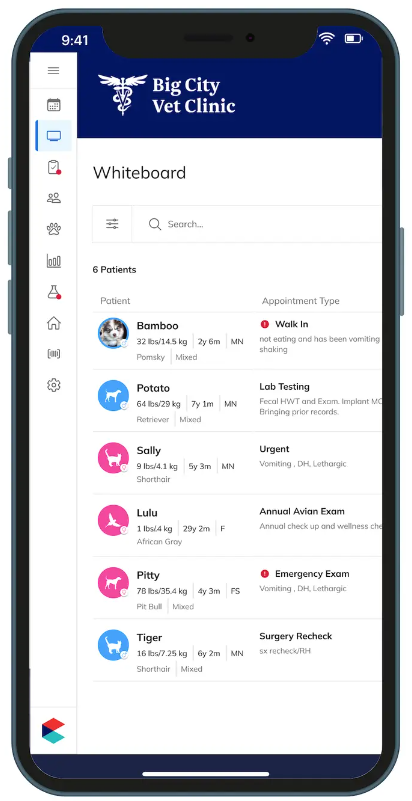
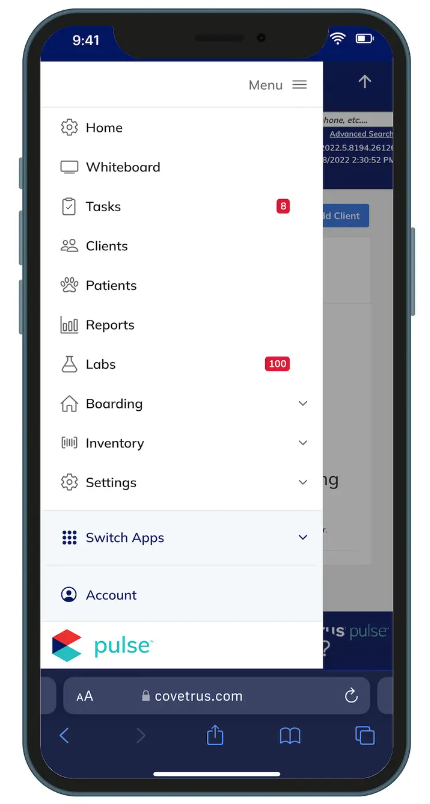
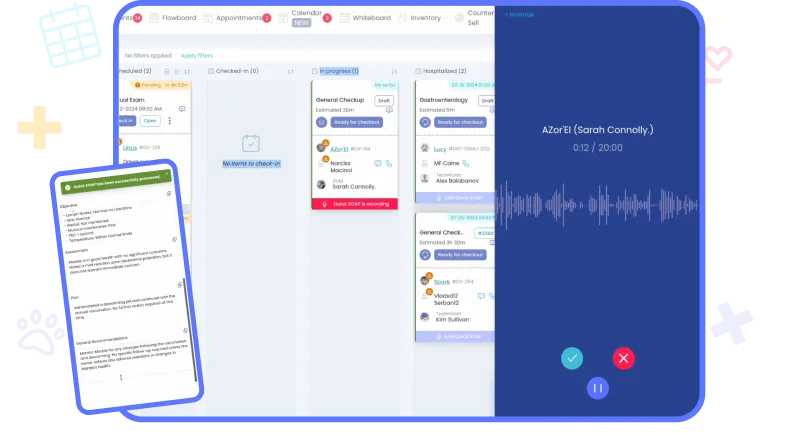
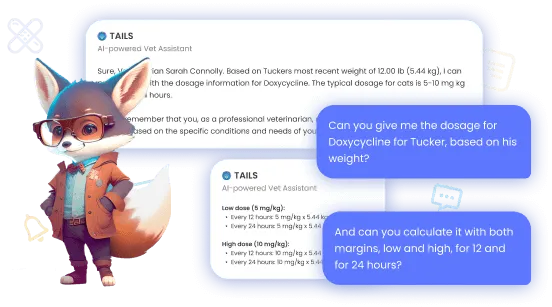
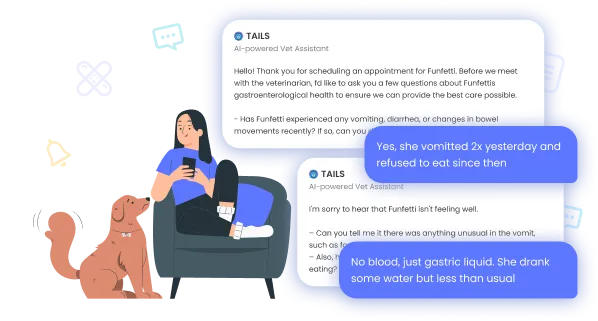
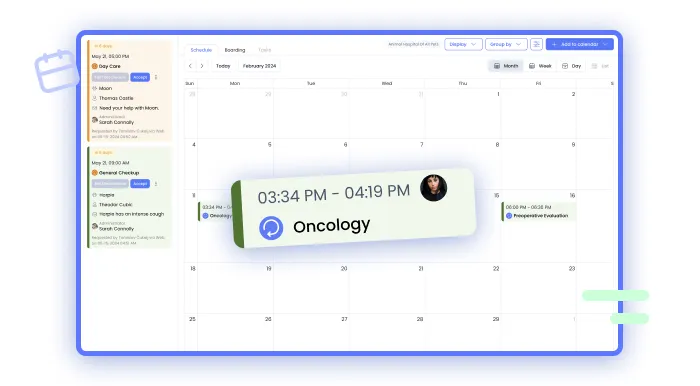
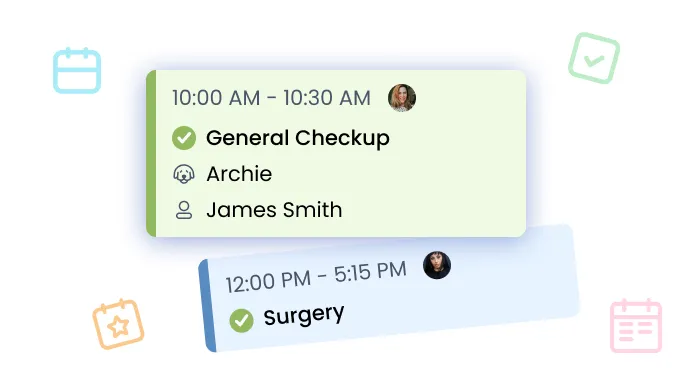
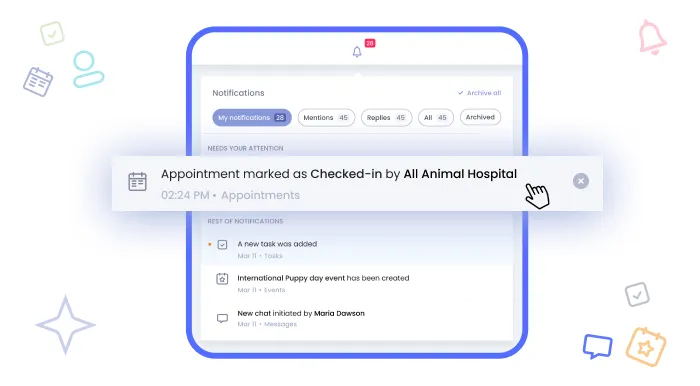
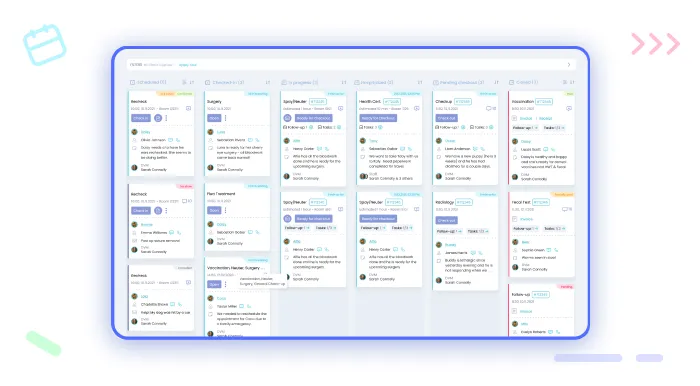
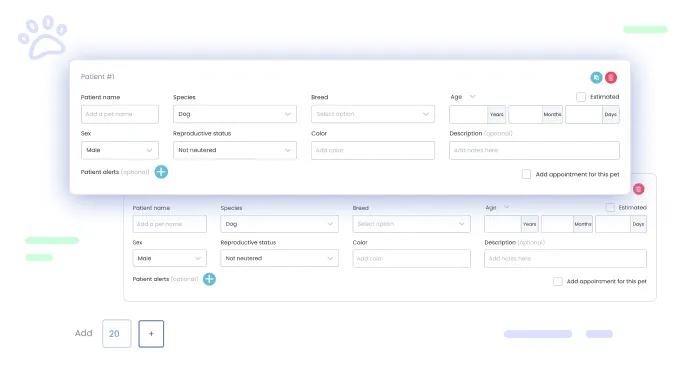
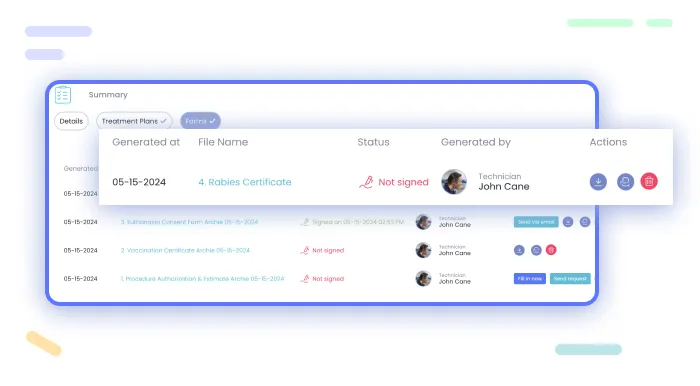
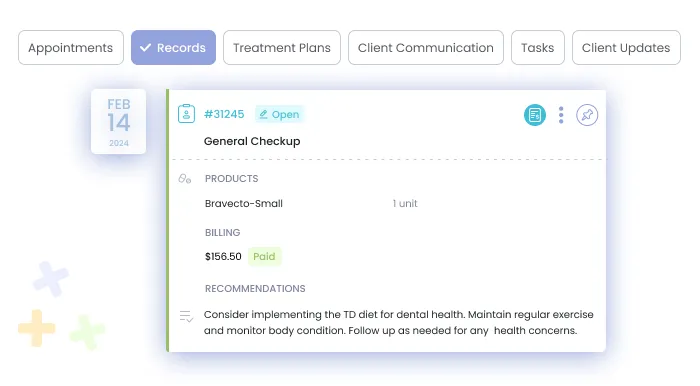
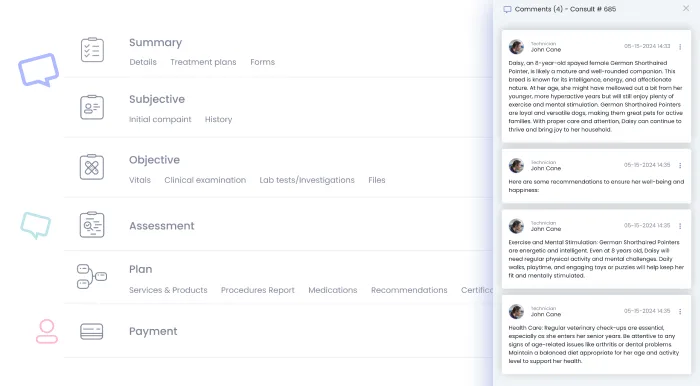
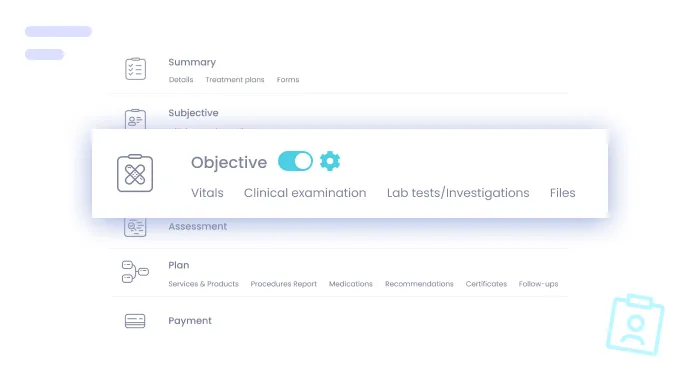
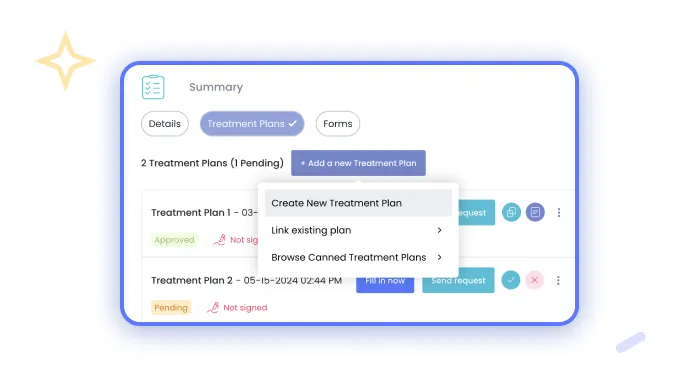
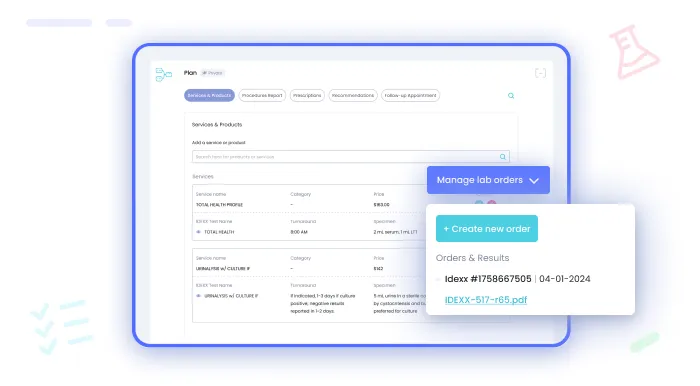
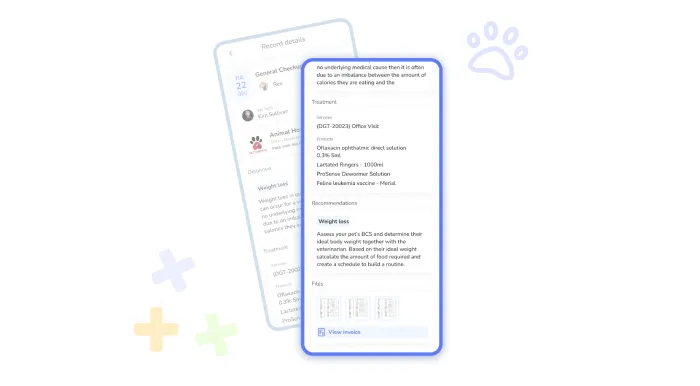
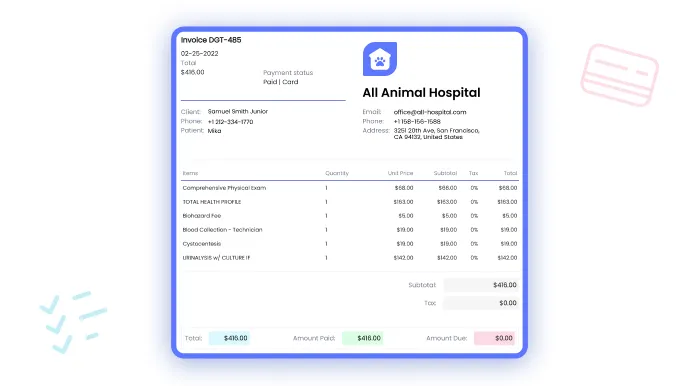
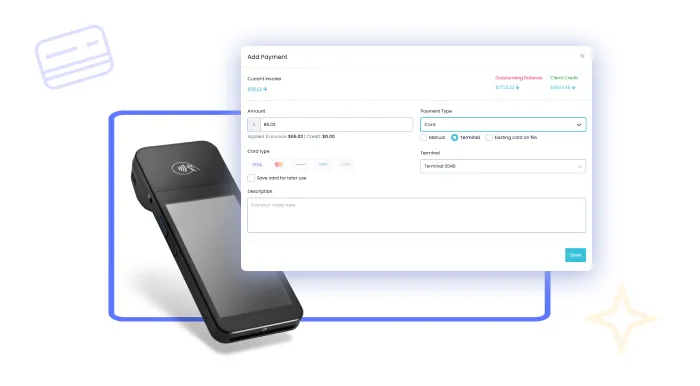
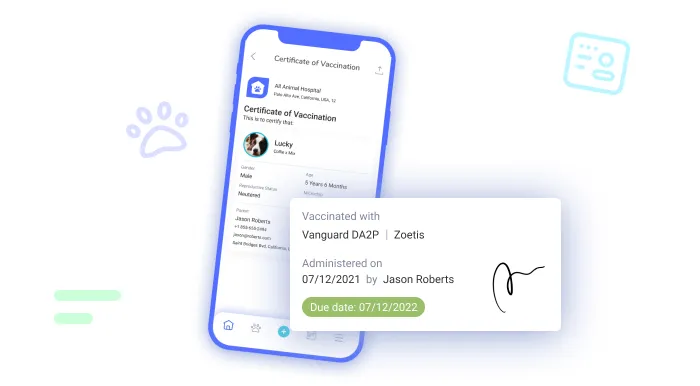
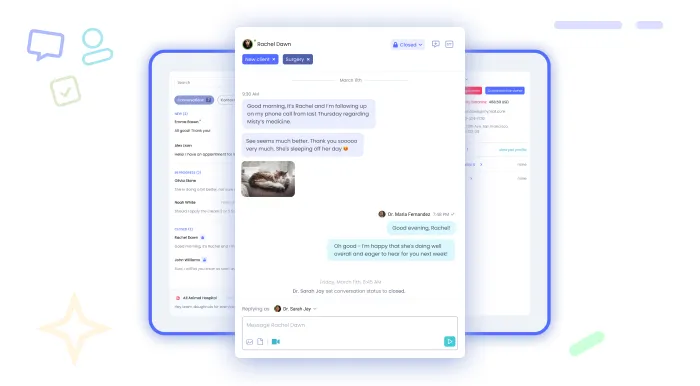
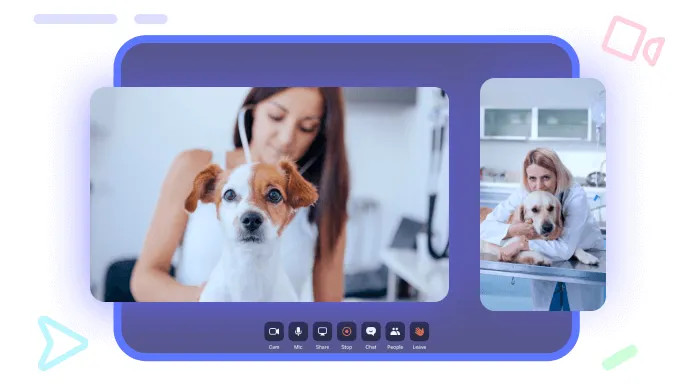
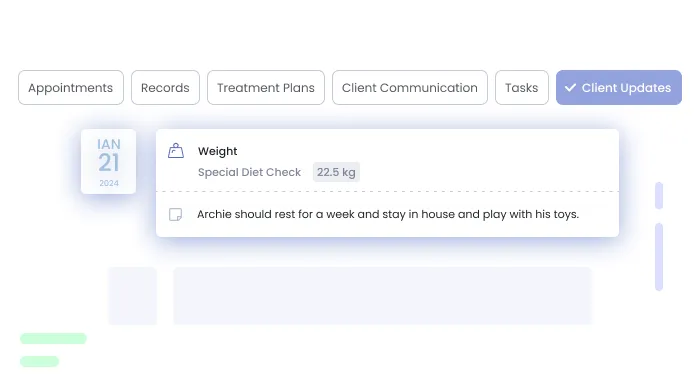
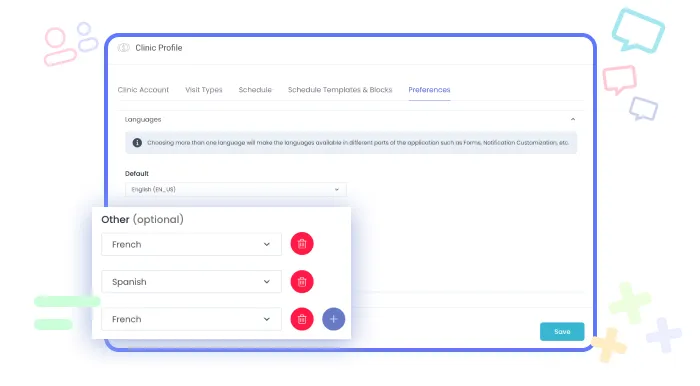

.jpg)
.jpg)
.jpg)
.jpg)
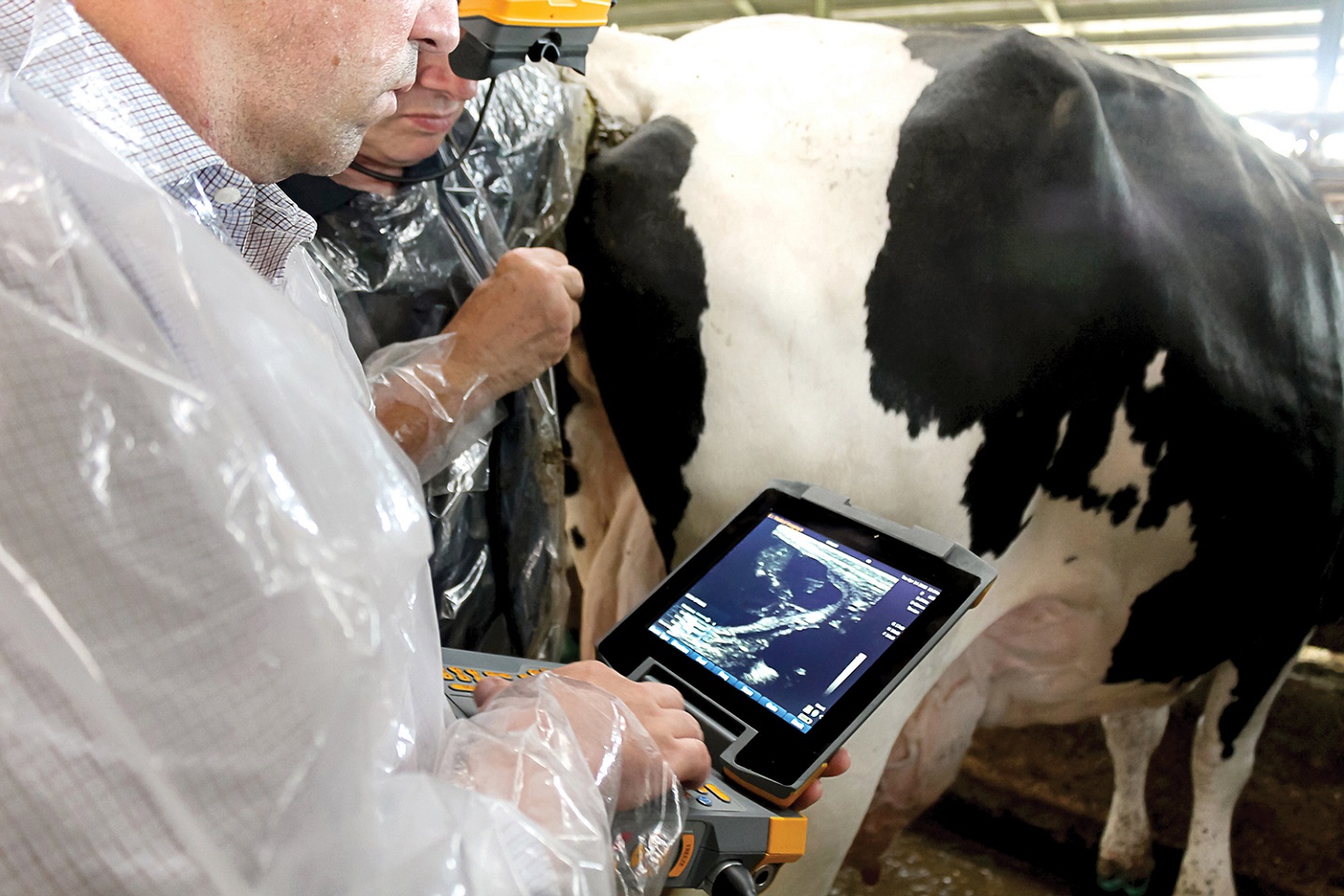
















We have been working for over 10 years and they have become our long-term technology partner. Any software development, programming, or design needs we have had, Belitsoft company has always been able to handle this for us.
Founder from ZensAI (Microsoft)/ formerly Elearningforce